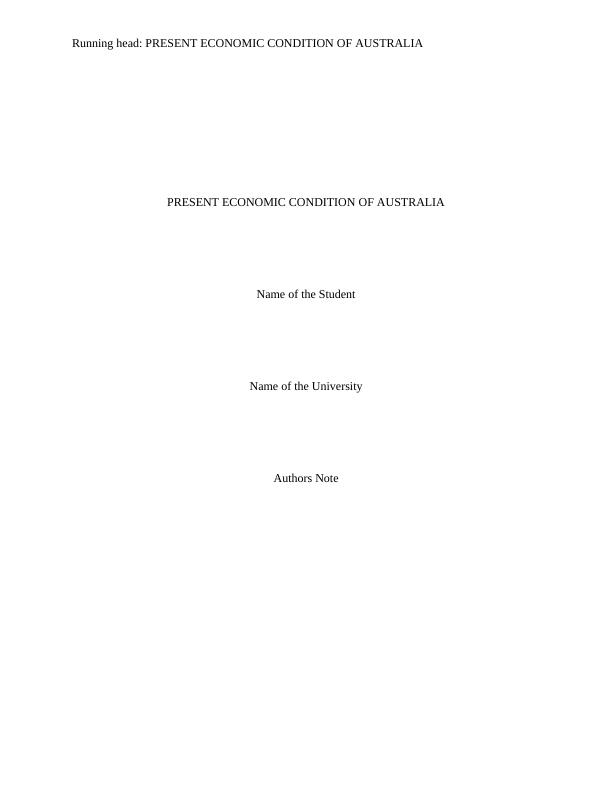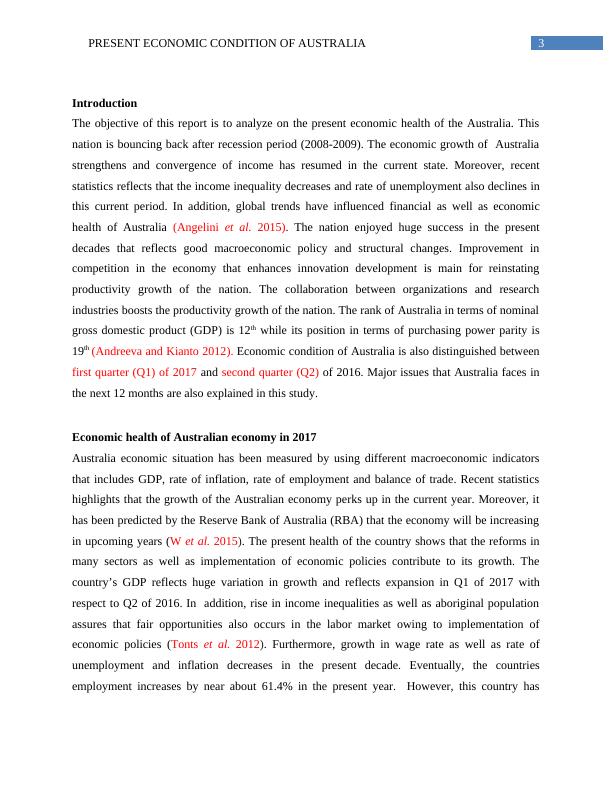Ask a question from expert
Present Economic Condition Of Australia
12 Pages2824 Words301 Views
Added on 2019-10-30
Present Economic Condition Of Australia
Added on 2019-10-30
BookmarkShareRelated Documents
Running head: PRESENT ECONOMIC CONDITION OF AUSTRALIAPRESENT ECONOMIC CONDITION OF AUSTRALIAName of the StudentName of the UniversityAuthors Note

1PRESENT ECONOMIC CONDITION OF AUSTRALIAExecutive SummaryThe objective of this paper is to elucidate the present economic condition of Australia andcompare the economic state in first quarter (Q1) of 2017 and second quarter (Q2) of 2016. Theeconomic health of Australia is explained by using macroeconomic indicators such as rate ofinflation, unemployment rate, inflation rate and balance of trade. Expansionary monetary policyimplemented by RBA facilitates in stabilizing economic output and enhances country’s growth.Proper economic policy instrument aids in easing cyclical fluctuations. The nation enjoyed hugesuccess in the present decades that reflects good macroeconomic policy and structural changes.Improvement in competition in the economy that enhances innovation development is main forreinstating productivity growth of the nation. In addition, interest rate set by RBA changesaccording to variation in economic situations. Furthermore, adoption of fiscal policy by RBAfacilitates in administering the demand in the present market. These policies also affect theavailability of credit. Therefore, if the nation expands in higher rate, then RBA tries to raise thecash rate in order to decrease aggregate spending. On the contrary, during difficult phase, thenation tries to reduce interest rate. For stabilizing the Australian economy, the RBA focuses instabilizing price and full employment. Furthermore, the federal bank of Australia keeps the rateof inflation below 2% for preserving the cash value and motivates growth within the economy.The nation faces current account deficit owing to low generation of savings for financinginvestment needs. In addition, expansion in trade also aids the country in increasing productivityand national income. It has been noted that FDI (Foreign Direct Investment) also enhancesdevelopment and living standards of the Australians. It also led to changes in segments of themarket that stimulates overall production and competition among the business. Implementationof economic policies also facilitates in reducing unemployment issues within the nation. Thisreport also reflects the main issues that this economy might face over the next 12 months. Theseproblems include tax system, ageing population and infrastructure as well as capita investment.Changing tax system affects the personnel participation rate. In addition, this nation also faceshuge challenges for developing big projects. Escalating cost of health associated withadvancement of technologies enhances fiscal pressures. Australia also faces competition pressurefrom other economies in terms of availability of inadequate capital.

2PRESENT ECONOMIC CONDITION OF AUSTRALIATable of ContentsIntroduction......................................................................................................................................3Economic health of Australian economy in 2017............................................................................3Distinguishing economic condition of Australia of Q1 of 2017 with respect to Q2 of 2016..........4Some main issues that this nation will face over the next 12 months.............................................8Conclusion.......................................................................................................................................8References......................................................................................................................................10

3PRESENT ECONOMIC CONDITION OF AUSTRALIAIntroductionThe objective of this report is to analyze on the present economic health of the Australia. Thisnation is bouncing back after recession period (2008-2009). The economic growth of Australiastrengthens and convergence of income has resumed in the current state. Moreover, recentstatistics reflects that the income inequality decreases and rate of unemployment also declines inthis current period. In addition, global trends have influenced financial as well as economichealth of Australia (Angelini et al. 2015). The nation enjoyed huge success in the presentdecades that reflects good macroeconomic policy and structural changes. Improvement incompetition in the economy that enhances innovation development is main for reinstatingproductivity growth of the nation. The collaboration between organizations and researchindustries boosts the productivity growth of the nation. The rank of Australia in terms of nominalgross domestic product (GDP) is 12th while its position in terms of purchasing power parity is19th (Andreeva and Kianto 2012). Economic condition of Australia is also distinguished betweenfirst quarter (Q1) of 2017 and second quarter (Q2) of 2016. Major issues that Australia faces inthe next 12 months are also explained in this study.Economic health of Australian economy in 2017Australia economic situation has been measured by using different macroeconomic indicatorsthat includes GDP, rate of inflation, rate of employment and balance of trade. Recent statisticshighlights that the growth of the Australian economy perks up in the current year. Moreover, ithas been predicted by the Reserve Bank of Australia (RBA) that the economy will be increasingin upcoming years (W et al. 2015). The present health of the country shows that the reforms inmany sectors as well as implementation of economic policies contribute to its growth. Thecountry’s GDP reflects huge variation in growth and reflects expansion in Q1 of 2017 withrespect to Q2 of 2016. In addition, rise in income inequalities as well as aboriginal populationassures that fair opportunities also occurs in the labor market owing to implementation ofeconomic policies (Tonts et al. 2012). Furthermore, growth in wage rate as well as rate ofunemployment and inflation decreases in the present decade. Eventually, the countriesemployment increases by near about 61.4% in the present year. However, this country has

End of preview
Want to access all the pages? Upload your documents or become a member.
Related Documents
ECO 10250 Report - The City College of New Yorklg...
|12
|2565
|39
Role of Fiscal Policy in Stabilizing the Australian Economylg...
|20
|3091
|45
Assignment on Macroeconomic Environment of Australialg...
|19
|3617
|26
Economics for Decision Makinglg...
|12
|2395
|500
Macroeconomic Analysis of Australia using Aggregate Expenditure Modellg...
|13
|2403
|346
Economic Performance of Australia: GDP, Unemployment, Inflation and Tradelg...
|12
|2399
|330